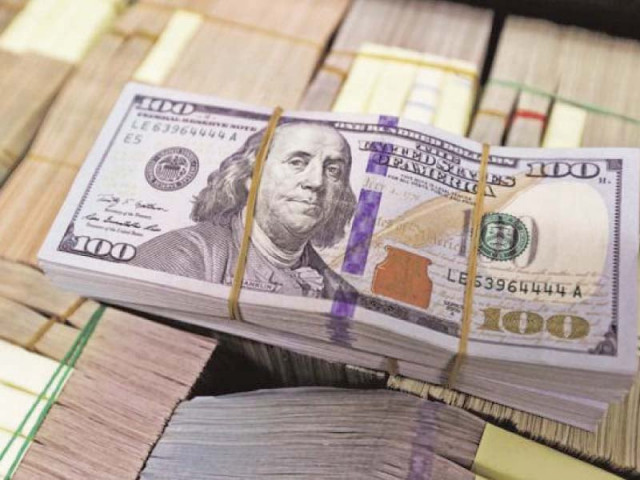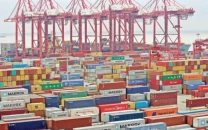Troubles ahead: Balance of payments crisis appears far from over
Net international reserves stand at negative, SBP’s short-term liabilities at $12.2b

According to the IMF’s standard definition of the Net International Reserves (NIR), the central bank’s reserves would be negative $9.7 billion after including its total $6 billion obligations. PHOTO: REUTERS
The SBP’s up to one year obligations exceed its gross official foreign currency reserves by at least $4 billion. Against $8.2 billion gross official reserves as of last week, the SBP’s short-term liabilities stand at nearly $12.2 billion.
The current gross official $8.2 billion reserves are largely maintained by taking short-term loans from commercial banks and taking Chinese and Saudi deposits under the currency swap arrangements.
As of September this year, the central bank borrowed $7.22 billion from commercial banks under the forward and currency swap arrangements, according to data that SBP released on Wednesday. The central bank was required to return $1.5 billion within one month, $3.2 billion in two months and remaining $2.6 billion up to one year, according to the official data.
The commercial banks swap deals are signed in the range of 2.5% to 4% interest rates, according to the banking sector sources.
In addition to this, SBP owes $3 billion to China, $1 billion to Saudi Arabia and $700 million to other sources, according to the sources. Around $453 million were to be repaid to the IMF in this fiscal year, which will be a direct charge on the SBP reserves.
This has resulted into negative $4 billion foreign currency reserves.
According to the IMF’s standard definition of the Net International Reserves (NIR), the central bank’s reserves would be negative $9.7 billion after including its total $6 billion obligations. But the IMF’s $6 billion repayments are spread over next five years, therefore, all the amount cannot be excluded against short-term liabilities of the central bank.
At the end of the Pakistan Muslim League-Nawaz (PML-N) tenure, the SBP’s foreign currency swap position was $6.7 billion.
“The $7.22 billion foreign currency swaps must have been avoided due to the country’s bad experience in late 1990s,” said former finance minister Dr Hafiz Pasha. He said that the then government had to pay the foreign currency deposit holders in rupee at a premium rate after it exhausted their deposits.
In 1998, the then PML-N government had consumed foreign currency deposits of commercial banks after global powers imposed sanctions on Pakistan in retaliation to nuclear bomb explosions.
The $7.22 billion loans have been obtained by the central bank from commercial banks under F-25 and F-3 circulars, taking benefits of the foreign currency deposits of Pakistanis as well as foreign nationals, according to the sources in the banking sector.
The loans obtained under F E-25 circular are also shown part of both the central bank and commercial banks’ reserves. This is tantamount to double-booking of the currency reserves. Few months ago, Dr Asfhaque Hasan Khan, now a member of the Economic Advisory Council, had also termed the SBP’s foreign currency swaps deal as double booking. He had suggested that the swaps should have been excluded from the commercial banks’ reserves.
After receiving commitments from the friendly countries, Finance Minister Asad Umar had said that Pakistan’s balance of payments crisis was over. Prime Minister Imran Khan had also endorsed the finance minister’s statement in a cabinet meeting.
So far only Saudi Arabia had given firm commitments for providing $6 billion lifeline. The commitments from United Arab Emirates and China were still unclear. There is high possibility that China may rollover its $3 billion safe deposits that are due by end of this fiscal year. Pakistan’s talks with the IMF for a bailout package also failed, as both the sides could not converge on the main thorny issues including provision of data related to Chinese public and publically guaranteed debt.
In an interview with the Bloomberg on Wednesday, the finance minister said the government was not in a hurry to obtain a bailout package from the IMF to boost the country’s foreign exchange reserves. The wire agency quoted the minister as saying that, “We aren’t in a hurry. We are covered even if it delays for two months.”
There was a massive increase in contracting short-term loans after the expiry of the last IMF programme in September 2016. During its three-year programme, the IMF had kept Pakistan under check by placing two main conditions. One was related to the Net International Reserves that is calculated by excluding the impact of currency swap loans. The other was on reducing the short-term loans obtained under currency swap arrangements.
When the IMF programme ended, the forward and currency swap-related obligations of the SBP amounted to negative $765 million in September 2016. In two years, these obligations swelled by almost ten times.
Published in The Express Tribune, November 29th, 2018.
Like Business on Facebook, follow @TribuneBiz on Twitter to stay informed and join in the conversation.



















COMMENTS
Comments are moderated and generally will be posted if they are on-topic and not abusive.
For more information, please see our Comments FAQ